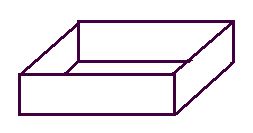Applications of Derivatives: Optimization
Example: Design a box, open at the top, to be made in one piece from a 24inch by 9inch sheet of cardboard which will have the maximum possible volume. Like this:

__________________________________________________________________________________
What is it we are trying to optimize?
We want to maximize the volume, V.
What will our final answer look like? What variable(s) are we looking for?
The overall dimensions of the box, height, length, and width. Let’s label them x,y,z.
We need a 2 dimensional sketch now to label these and help us visualize the problem.
NEED SKETCH
If we cut out the corners and fold up along the dashed lines, we’ll have a box. The dimension, x is critical, so we label it. The height then is x.
Now we need an equation. What is the general equation for the volume of a rectangular box?
V = xyz
And we’ll need to put that in terms of only one variable, say, x, the height. Look at the sketch and express the length and width in terms of x.
V = x(9-2x)(24-2x)
Now that we have an equation for volume in terms of one variable, x, we can take the derivative, set it equal to zero, and solve for x. First we multiply it out.
V = 216x – 66x2 + 4x3
dV/dx = 216 – 132x + 12x2
dV/dx = 12(18 – 11x + x2)
0 = 12(18 – 11x + x2)
0 = (9-x)(2-x)
x = 9, 2
Of course x = 9 would be too large, so we use x = 2.
Solution: Box size: 2inch x 5inch x 20inch for a volume of 200inch3





